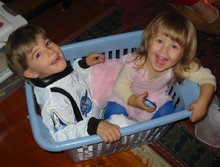What's up with all those gnomes and fairies?
[Fairies and gnomes] actually come from people's experiences of elemental forces that help the plants to grow or the minerals to form. These "sightings" or "sensings" occur cross culturally, although we are pretty steeped in the European tradition of how these "elemental beings" are talked about and represented in visual form. There is a kind of "truth" in how they are represented in paintings or knitted figures, because the person rendering them is trying to convey certain archetypal truths.
-- Rahima Baldwin Dancy, Waldorf in the Home
One thing that many people notice about Waldorf early childhood classrooms are the gnomes and fairies. Little knitted or felt gnomes might live in a basket ready for children to play with, or silk fairies might hang from golden threads above a springtime nature table.
Kindergarten teachers might lead their children in a circle game about gnomes marching through the forest with heavy sacks of jewels, or sing songs about fairies helping the bees to find nectar in summer blooms.
So, what's going on with this? Why all the emphasis on mythical beings?
Waldorf early childhood methods emphasize imaginative play. We also try to foster the child's natural sense of being "one" with the world and with nature. Children love to be outside, playing with water, mud, sticks, rocks, and flowers.
Children also have a natural feeling that everything around them is "alive." Rocks can talk, trees have feelings, and certainly there are invisible beings all around us helping with natural processes. Fairies and gnomes are a physical manifestation of this feeling of the aliveness of nature.
On another level, fairies and gnomes could be seen as representations of the opposing forces that human beings must try to balance: Fairies are pure spirit, hardly touching the Earth, and working with the forces of life and growth. Gnomes are pure matter, living and working under the earth in the mineral realm, and working with the forces of death and hardening.
Here in our house we have lots of gnomes and fairies around. We've got one in the fridge, for example, who lets us know he's happy with the food selection by making loud knocking sounds occasionally. The kids have numerous little gnomes made of felt, wood, and that dashing knitted fellow you see above. I feel that bringing in a bit of this archetypal, elemental world is one way to work imaginatively with forces and processes that are otherwise invisible, and it encourages the kids to use their imaginations.
I'll give one last personal example of why I like to incorporate the "little people" in my little people's lives:
At night we can see some lights in the distance out of a window in the kids' room. One night I told them that perhaps those were the lights of a far-off fairy castle. I wove a story about how the fairies were so busy all day helping the plants to grow, flowers to bloom, etc. that it wasn't until nighttime that they could rest in their castle. We talked about how they have grand processions (are those lights over there flaming torches lighting their way?) and how they love to dance after they've eaten their feast (are those lights the glow of the stoves in their huge kitchens?). The kids were full of wonder and their eyes shone.
The kids often refer to the fairy castle lights, even though I told that story long ago and haven't mentioned it to them since. They really took in those images and can work with them in an imaginative way. They have never once made the connection between the fairy castle's lights and the building that sits there in the daytime!



No comments:
Post a Comment